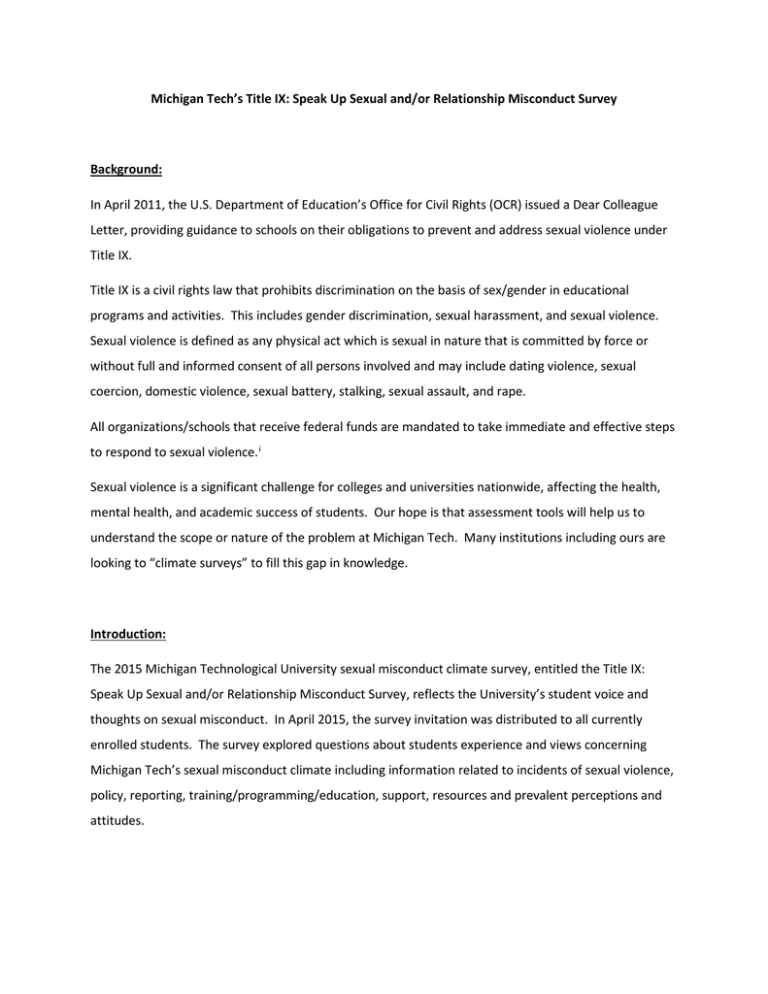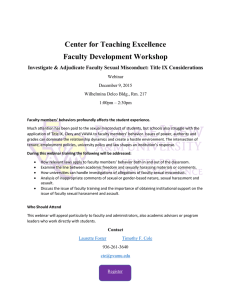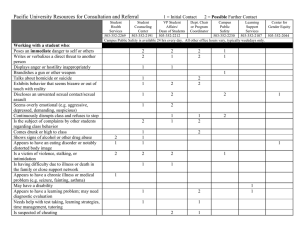
Michigan Tech’s Title IX: Speak Up Sexual and/or Relationship Misconduct Survey
Background:
In April 2011, the U.S. Department of Education’s Office for Civil Rights (OCR) issued a Dear Colleague
Letter, providing guidance to schools on their obligations to prevent and address sexual violence under
Title IX.
Title IX is a civil rights law that prohibits discrimination on the basis of sex/gender in educational
programs and activities. This includes gender discrimination, sexual harassment, and sexual violence.
Sexual violence is defined as any physical act which is sexual in nature that is committed by force or
without full and informed consent of all persons involved and may include dating violence, sexual
coercion, domestic violence, sexual battery, stalking, sexual assault, and rape.
All organizations/schools that receive federal funds are mandated to take immediate and effective steps
to respond to sexual violence. i
Sexual violence is a significant challenge for colleges and universities nationwide, affecting the health,
mental health, and academic success of students. Our hope is that assessment tools will help us to
understand the scope or nature of the problem at Michigan Tech. Many institutions including ours are
looking to “climate surveys” to fill this gap in knowledge.
Introduction:
The 2015 Michigan Technological University sexual misconduct climate survey, entitled the Title IX:
Speak Up Sexual and/or Relationship Misconduct Survey, reflects the University’s student voice and
thoughts on sexual misconduct. In April 2015, the survey invitation was distributed to all currently
enrolled students. The survey explored questions about students experience and views concerning
Michigan Tech’s sexual misconduct climate including information related to incidents of sexual violence,
policy, reporting, training/programming/education, support, resources and prevalent perceptions and
attitudes.
Key Points:
•
Date Range Survey Completed: April 13, 2015 to April 20, 2014
•
The survey was administered by Michigan Technological University, with the administrative
assistance from Campus Labs: Baseline.
•
The survey should have taken most students about 30 minutes or less to complete.
Participation was voluntary, and students may have chosen to skip questions or stop responding
at any point.
•
The on-line survey was distributed vial email to all currently enrolled graduate and
undergraduate students. It asked questions about their views regarding campus climate,
including information related to incidents of sexual violence, policy, reporting,
training/programming/education, support, resources and prevalent perceptions and attitudes.
•
A total of 6,597 survey invites were distributed. The number of respondents was 686 students,
which is approximately 10% of the student population. Of these respondents, 21% were
graduate students and 79% undergraduate students, 47% identified as female, 51% identified as
male, 2% identified as transgender/gender non-binary. The survey was not distributed to
anyone under 18 or any dual enrolled students.
•
Responses were anonymous. Responses were reported in terms of groups of students rather
than as individual cases.
•
Students were made aware that by responding, they were not making an official report of the
incidents(s).
•
The survey questions used in the Michigan Tech survey were among the best currently available
to institutions, recommended by the federal government’s Not Alone: Together Against Sexual
Assault website.
•
We use the term “survey” to mean a standard set of questions given to participants, in a
questionnaire, to assess different aspects of campus climate in regard to sexual and/or
relationship misconduct.
•
Students were asked about their experience in the current academic year, not prior history.
This enables us to gauge scope and nature of the problems during their time as a student at
Michigan Tech.
•
Due to the sensitive nature of the questions, no questions “required response.” This means that
students would sometimes skip questions, causing the number of responses to vary.
Why was a sexual misconduct climate survey conducted and why now?
The federal government has stated that conducting a regular climate survey concerning sexual
misconduct/violence is a best practice response to campus sexual misconduct.
We know from decades of research that victims rarely report sexual assault to law enforcement. Many
victims do not access formal services, like crisis centers. Thus, official statistics underrepresent the
extent of the problem on any one campus. Further, campus response, intervention, and prevention
efforts will be more successful if they are tailored to the needs of each campus community.
Understanding climate issues, such as students’ knowledge about reporting policies and resources for
victims, their attitudes about prevention, and their perceptions about how their community is
addressing the problem of sexual violence, are critical pieces of information for improving campus
responses. ii
We believe that as an institution, we will see benefits from conducting climate surveys. For example,
when campuses address sexual violence, victims may feel more comfortable coming forward, so the
rates of reporting such violence might increase and importantly we can help victims heal from the
trauma they have experienced, enabling them to stay in school, and feel confident in the school’s
handling of the violence.
Ultimately a decision was made to conduct a survey for Michigan Tech because even though it is not
required by the federal government at this time, the survey is a benchmark. It is important for us to
know what is happening on our campus. The survey offers us an understanding of the prevalence of
incidents of sexual violence on campus and provides us with helpful information regarding students’
thoughts and opinions of the sexual misconduct climate. As an institution, we have a responsibility to
protect our students from sexual misconduct and to create a safe campus community.
What is the value of climate surveys?
Not Alone: Together Against Sexual Assault, a federal government website, lists the following important
points:
•
Climate surveys can provide information about student perceptions, knowledge and attitudes
relevant to sexual assault (violence).
•
Incident rates assessed via confidential or anonymous surveys can be another source of data
about the extent of the problem.
•
Regularly administering surveys can show changes over time, such as decreases in sexual
assaults (violence) and increases in awareness or reporting.
•
Surveys can provide information about the problem in a particular campus community, enabling
schools to tailor prevention and response efforts.
•
Conducting a climate survey can demonstrate the university’s commitment to addressing sexual
assault (violence) and build trust with students, faculty, parents, and others.
Summary of Findings:
Sexual and/or relationship misconduct has been identified as a national problem that significantly
impacts college and university students. Federal and state laws place requirements upon colleges and
universities to address issues of sexual and/or relationship misconduct. The University is committed to
educating students, faculty, and staff about this topic; and to working with the surrounding communities
and resource centers to offer as great a variety of services as possible. The University’s Student Code of
Community Conduct expressly prohibits sexual and/or relationship misconduct. Sexual and/or
relationship misconduct includes sexual harassment; sexual assault; sexual exploitation; domestic
violence; dating violence and stalking. iii
A 2007 campus sexual assault study by the U.S. Department of Justice found that approximately 1 in 5
women and 1 in 16 men are targets of attempted or completed sexual assault while they are college
students. The Rape, Abuse, and Incest National Network(RAINN) reports that college-aged women are
four times more likely than any other age group to face sexual misconduct. iv It also notes that sexual
violence is underreported for all genders and gender identities.
Each year schools disclose the number of sexual assaults reported on campus in their annual security
reports, and to the U.S. Department of Education. In 2013, the requirements for schools were updated
as part of the Violence Against Women Reauthorization Act(VAWA). Colleges and universities will now
also disclose the annual number of domestic violence, dating violence, and stalking incidents reported.
For all these reasons, we are sharing some key findings of Michigan Tech’s Title IX: Speak Up Sexual
and/or Relationship Misconduct campus survey.
Key Findings:
•
Overall, Michigan Tech students strongly agree or agree that faculty and staff are concerned
about their welfare. They feel like they are a part of Michigan Tech and that Michigan Tech has a
good support system for students going through difficult times.
•
Approximately 97% (658 students) of Michigan Tech students who responded to the survey said
that they feel safe on the Michigan Tech campus, and 91% (615 students) said they believe
protecting the safety of students is a priority for the University.
Sample Survey Questions
•
Question: “Since the beginning of this current academic year, has anyone had sexual contact
with you by using physical force or threatening to physically harm you?” Eleven students said
YES (2%) and 585 students said NO (98%).
•
Question: “Since the beginning of this current academic year, has anyone attempted but not
succeeded in having sexual contact with you by using physical force or threatening to physically
harm you?” Fourteen students said YES (2%) and 583 students said NO (98%).
•
Question: “Since the beginning of this current academic year, did you have sexual contact from
someone when you were unable to provide consent or stop what was happening because you
were passed out, drugged, drunk, asleep?” Twenty-three students (4%) said YES and 574 (96%)
said NO. When a student responded YES to this question, they indicated the following occurred:
Count
Respondent %
Response %
20
71.43%
39.22
Forced touching of a sexual nature
9
32.14%
17.65%
Oral sex
10
35.71%
19.61%
Sexual intercourse
2
7.41%
3.92%
Anal sex
7
25.00%
13.73%
Sexual penetration with a finger/object
3
10.71%
5.88%
Don’t know
NOTE: This question said, “Check all that apply.” Therefore, 28 students produced 51 responses.
Analysis of Results
•
It is important to acknowledge, as we did in the survey, that even if a student had been drinking,
the student is in no way responsible for any sexual violence that may have occurred. That being
said, 25 of the 28 students indicated that unwanted sexual misconduct incidents occurred under
the influence of alcohol.
•
More than two-thirds of nonconsensual sexual experiences occurred off or near campus.
Approximately one-third occurred on campus.
•
In most cases, students who had an unwanted sexual experience said another Michigan
Technological University student was responsible. This is consistent with national data
indicating that an overwhelming majority of victims know their attacker.
•
Among students who said they had a least one unwanted sexual experience at Michigan Tech,
84% told someone else, most often a friend or a roommate. One in four of those students said
they reported the incident to law enforcement or an official University resource, including
Counseling Services, Residence Hall staff and the Title IX Coordinator. (Note: Counseling Services
is a designated confidential resource so reporting is not “mandated.”)
•
When asked why they did not report their experience, most students who responded said they
did not want to get the person responsible in trouble, felt it was a private matter, and/or
wanted to deal with it on their own. A significant number of students also felt embarrassed or
ashamed, and some said they did not have time to deal with it due to academics, work etc.
•
Most students indicated they strongly agree or agree that Michigan Tech officials handle
conduct incidents in a fair and timely manner.
•
In regard to bystander intervention, 427 students (76%) felt “extremely confident” that they
could, “express their discomfort if someone said that rape victims are to blame for being raped.”
And 437 students (79%) felt “extremely confident” that they would “Ask a friend if he/she needs
to be walked home from a party.”
•
As for consent, 527 of the students who responded to the survey (96%) felt it “likely or
extremely likely” that they would stop having sex with a partner if he/she says to stop, even if it
started consensually. Additionally, 469 students responding (85%) said they were either “likely
or extremely likely” to not engage in sex with a partner if he/she is drunk.
Preliminary recommendations:
In reviewing these Title IX: Speak Up Sexual and/or Relationship Misconduct survey results, we can now
begin to assess the scope of the problem and the examine the effectiveness of our policies, procedures,
reporting, training/programming/education, support, and resources. In general, is it clear that our
students feel safe on campus and will “Speak Up” to assist a fellow student. This is encouraging, and also
can be misleading in regard to the issues of sexual misconduct. Sexual violence happens on all college
campuses, and our students need to be aware and educated.
Upon reflection on the survey results, we will continue to improve our awareness and educational
programming, make the response and reporting processes easier to understand, and continue to focus
on increasing support and resources for victims of sexual misconduct. The data collected will help us in
our prevention efforts and in creating a safer campus.
In the fall semester of 2015, the survey findings will be discussed in depth with the Title IX Awareness
Committee, as well as students and department representatives from all areas of the campus
community. This input will further assist improvement of programs and response to sexual and/or
relationship misconduct and recommendations for a safer campus.
i
Dear Colleague Letter 2011---http://www2.ed.gov/about/offices/list/ocr/letters/colleague-201104.pdf
ii
https://www.notalone.gov/assets/ovw-climate-survey.pdf
iii
http://www.mtu.edu/conduct/policies/student-conduct/sexual-misconduct/
iv
https://www.rainn.org/statistics



